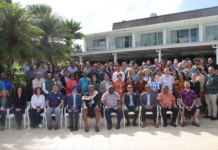By Warief Djajanto Basorie
Three hundred schoolchildren from the greater Jakarta area sat on a red carpet covering the cavernous Soedjarwo auditorium—named to honour the country’s first forestry minister—at the Ministry of the Environment and Forestry in January this year.
They were there to participate in the government-led Climate Festival; the theme was “Three Years of Climate Change Achievements”.
Dr Nur Masripatin, the then Director General of Climate Change (she stepped down in February 2018), tossed the kids a question on climate change: what will become of Indonesia if nothing is done about climate change by 2030?
An elementary schoolboy said the country would become hotter and drier. Another two students added to his answer, talking about global warming and the greenhouse gases that lead to climate change.
The director-general beamed broadly. Dr Nur Masripatin, who has a PhD in forest biometrics from Canterbury University in New Zealand, has been a veteran negotiator for Indonesia at the annual United Nations climate conference since 2005.
Indonesia is a country of islands, with a majority of the population living along coasts vulnerable to climate change, she explained to the assembled pupils. The government hopes that such an event will equip children with information on climate change that they’ll carry into adulthood.
Reaching Indonesia’s targets
The event also sought to inform the public on the progress made in implementing international agreements and national policies, such as the Paris Agreement and the Nationally Determined Contribution, related to climate change. Government projects such as this one are only deemed successful if the people meant to benefit from the project feel that they have a stake in the issue, and commit to seeing it through.
The Paris Agreement, reached at the UN climate conference in Paris in 2015, is a legally binding international contract to limit global warming “well below” 2˚C, through lowering carbon emissions from the burning of fossil fuels and the degrading of forests. The ultimate aim is zero carbon emissions worldwide by 2050.
In undertaking to realise the Paris Agreement, Indonesia’s Nationally Determined Contribution, or NDC, sets a target of cutting emissions by 29 percent against a “business as usual” scenario (in which no planned action is taken) and by 41 percent with international cooperation. This climate action plan is due to be implemented from 2020 to 2030.
One of the many documents handed out to participants of the Climate Festival was the country’s NDC Implementation Strategy, listing nine programmes with assigned activities spanning from ownership and commitment development to implementation and review. Also included was an academic paper on the draft government regulation for climate change.
The festival, and its accompanying books, talks, and handout material produced by the director general and her team, outlines an ambitious climate agenda. Yet what’s not covered is interesting, too.
While the NDC Implementation Strategy cites projected greenhouse gas emission levels, it does not provide details on whether, or how much, emissions have already been reduced since 2011, when the government issued its national action plan to reduce greenhouse gas emissions by 26 percent by 2020. Nor does the NDC explain the formula it uses to reduce emissions in the five slated sectors: land-use, energy, IPPU (industrial processes and product use), agriculture and waste. The first two sectors alone produced 82 percent of the country’s carbon emissions in 2010–2012.
Despite its absence in the Climate Festival’s documents, information on emission reduction is provided by the National Development Planning Agency (Bappenas). From 2010–2017, Indonesia has cut greenhouse gas emission by only 13.46 percent. It’s a figure the Indonesian government aren’t eager to publicise—it’s a long way from their target. The government doesn’t officially state how much carbon emissions has been reduced because the NDC does not start until 2020, a government official explained.
“The government shall regularly provide emission reduction achievements in line with the NDC target it has committed to after Indonesia ratified the Paris Agreement. This is in line with our commitment to the NDC up to 2030. The information can be accessed in SIGN SMART prepared by the Environment and Forestry Ministry,” says Dr Agus Justianto, Head of the Ministry’s Agency for Research, Development and Innovation.
A major emitter of greenhouse gases
According to the World Resources Institute (WRI), Indonesia is the world’s sixth largest emitter of greenhouse gases, and the largest contributor of forest-based emissions—an unsurprising fact if one thinks back to the devastating forest and peat fires in 2014 and 2015. Images from the United States’ National Aeronautics and Space Administration (NASA) released in 2014 and 2015 show dense smoke blanketing parts of the country and its neighbours. Those two years were exceptionally bad, but such burning takes place annually.
In September 2017, WRI Indonesia published a 36-page working paper on how Indonesia can achieve its climate change mitigation goal. The organisation found that existing policies in the land-use and energy sectors, even if fully implemented, are inadequate if the country is really serious about reaching the 29% target by 2030. Using its own methodology, WRI Indonesia estimated that the existing policies would only result in a 19% reduction.
A failure to achieve its mitigation target means that Indonesia won’t be able to contribute its declared share in global fulfillment of the 2015 Paris Agreement.
Rethinking policies
Reaching the NDC goal would require revisiting existing policies, particularly in agriculture and energy.
In agriculture, the government wants to double the output of the highly lucrative oil palm by 2020. This would require the clearing of more forest and peatland to add to the 14 million hectares of oil palm plantations already present in the country—a move that would surely lead to more carbon emissions. The policy also undermines a forest moratorium, in place since 2011, on the issuing of permits to convert primary forest and peatland to oil palm plantations, pulp and paper estates and other land-use change activities.
Dr Agus denies any planned clearing of peatland, insisting that the moratorium is still in place. What the government wants to increase, he stresses, is productivity per hectare on existing oil palm plantations.
President Joko “Jokowi” Widodo also has a plan to boost the country’s energy capacity by 35,000 megawatts during his current term, which comes to an end in 2019. Only 2000 megawatts of that energy will come from renewable energy; 20,000 megawatts will come from coal-fired plants, another major source of greenhouse gas emissions. Oil and gas, as well as hydropower, will provide the rest.
This matter of generating 20,000 megawatts of energy from coal-fired plants was put to Bambang Brodjonegoro, Indonesia’s Minister for National Development Planning and Head of Bappenas, at the Southeast Asia Symposium jointly organised by Oxford University and the University of Indonesia’s School of Environmental Science.
The “best solution”, advocated by environmentalists, would be to phase coal-fired plants out completely and embrace renewable energy sources. It’s in line with the call of the “Powering Past Coal” alliance, a partnership of over 20 governments who intend to move away from coal. No Southeast Asian government has joined the alliance thus far.
Brodjonegoro, a former dean of the University of Indonesia’s School of Economics, replied that Indonesia’s plan relies on the “second-best solution”: new coal-fired power plants will use clean coal technology, and that renewable energy, such as solar, wind or biomass, will be developed for isolated areas that are not yet part of the country’s power grid. Energy is required for economic growth, he argued, and Indonesia has abundant coal deposits to meet that energy need.
But Indonesia might not need as much energy as policymakers initially thought. According to the Electricity Supply Business Plan 2018-2027 drafted by the Energy and Mineral Resources Ministry, a projection in Indonesia’s additional power needs dropped from 78 gigawatts under the 2017–2026 plan to 56 gigawatts in the 2018–2027 plan. The decrease was due to overestimating the growth in demand; if the government had followed through with the initial plan, it would end up overspending by building unused power plants.
Plans are also underway to increase the portion of renewable energy—while renewable energy only provided 12.52 percent of Indonesia’s energy in 2017, it’s expected to rise to 23 percent in 2025. Coal is expected to decline as a source of energy from 58.3 percent in 2017 to 54.4 percent in 2025. But environmental groups say it’s still not good enough.
“Many nations like India, China and even Saudi Arabia have altered their investment direction to renewable energy, whereas Indonesia still depends on coal for more than 50 percent of its power source,” said Hindun Mulaika, Greenpeace Indonesia’s climate and energy campaigner, in a recent press release.
Other organisations have called for more ambitious action from the Indonesian government. Germanwatch and Climate Action Network pointed out in their 2018 Climate Change Performance Index that Indonesia has the potential to further develop renewable energy, particularly since it has relatively large amounts of hydropower. WRI Indonesia recommended other mitigation actions, such as strengthening and extending the forest moratorium, restoring degraded forest and peatland, and implementing energy conservation efforts.
According to WRI Indonesia, increasing renewable sources in the energy mix will require implementing multiple policies, such as a carbon tax on fossil fuel power plants, the replacement of coal-fired plants with wind or solar sources, and the provision of subsidies for the promotion of renewable energy.
Indonesia already has bilateral and multilateral agreements for cooperation in climate change, such as an accord with Norway signed in 2010, where the Scandinavian country pledged up to USD1 billion for “significant reductions in greenhouse gas emissions from deforestation, forest degradation and peatland conversion”. The financial contribution is made based on a verified emissions reduction mechanism. However, an influential coal lobby makes it difficult for the country to take bolder steps away from coal power plants.
A target that cannot be achieved
As it stands, Indonesia’s 29 percent NDC target is not achievable, says a government technocrat.
“It is not based on what sectors knew, what the energy sector knew, what the road transport sector knew. No one has reliable data. Everyone has some sense of statistics,” says the technocrat, who has asked to remain anonymous as he’s not authorised to speak to the press.
The distinction between data and statistics is an important one—while statistics present a snapshot of one aspect of an issue, data is a real mapping of what exists, providing a more holistic picture. A good NDC should have reliable data from every sector, disaggregated to show the reality in each of Indonesia’s 465 sub-national districts and town governments. While there might be a political aspect to this process, politics should not be dominant, the official added.
“No one has reliable data. Everyone has some sense of statistics”
The lack of data is a big problem with a major impact on the way targets have been set. The government arrived at the 29% target via inter-sectoral meetings where each of the five mitigation sectors (energy, land-use, industry, agriculture, waste) stated how far they were willing to go in terms of reductions. But if the various groups only have “some sense of statistics” without actual reliable data, the targets set could easily be off the mark.
Hopes for a future generation
Indonesia’s climate future is not bleak; there’s still hope for significant progress moving forward. Beyond government policy and programmes, numerous civil society organisations are actively working on the issue.
One example is Climate Reality Indonesia, which had a booth at the Climate Festival. Its members, who have participated in Al Gore’s climate course, are from all walks of life: students, academics, public officials, business people, homemakers, journalists, artists, clerics. They’re committed to spreading climate awareness among their own circles to encourage a ripple effect that will increase public knowledge across the country.
“Climate change can be viewed from different angles: water, air, marine resources, forests, agriculture, energy, education, laws. Hence it’s important to break down the issue of interest to understand the ground sentiment,” says Amanda Katili Niode, manager of Climate Reality Indonesia.
There are signs that the public are interested. In 2015, a survey by the Pew Research Centre found that 63 percent of the country supported limiting greenhouse gas emissions as part of an international agreement. Climate Reality Indonesia is thus working on creating visual materials on specific climate change impacts and solutions to use in their outreach programmes.
Following Climate Change Director General Nur Masripatin’s session, Hidayatun Nisa, a 24-year-old university graduate, delivered a rousing speech before the assembled schoolchildren. She told them about her work as a facilitator in the Care of Peat Village project run by the Peat Restoration Agency in a village in Jambi province on the east coast of central Sumatra, calling on students to study how to protect the environment for a better future.
“I do hope the children can learn to be sensitive to living things and protect the environment where they live. This also applies to their parents as the educational process that has the greatest effect is the education at home,” says Nisa.
Without a change in gear for a more ambitious and robust emphasis on renewable energy and the safeguarding of the environment, Indonesia’s climate change ambitions could end up amounting to little more than a can’t-do plan. As it is, the current generation is already not on track to meet its own stipulated goals. If the country does not undertake a course correction soon, today’s Indonesian children will find themselves having to pick up the slack in the future.
Warief Djajanto Basorie is a contributor to New Naratif, an independent research and journalism publication. He has reported for the domestic KNI News Service in Jakarta 1971-1991 and concurrently was Indonesia correspondent for the Manila-based DEPTHnews Asia (DNA, 1974-1991). DNA is a feature service reporting on development in Asia for Asian media in English and the vernacular. This article is republished under a Creative Commons licence.














































